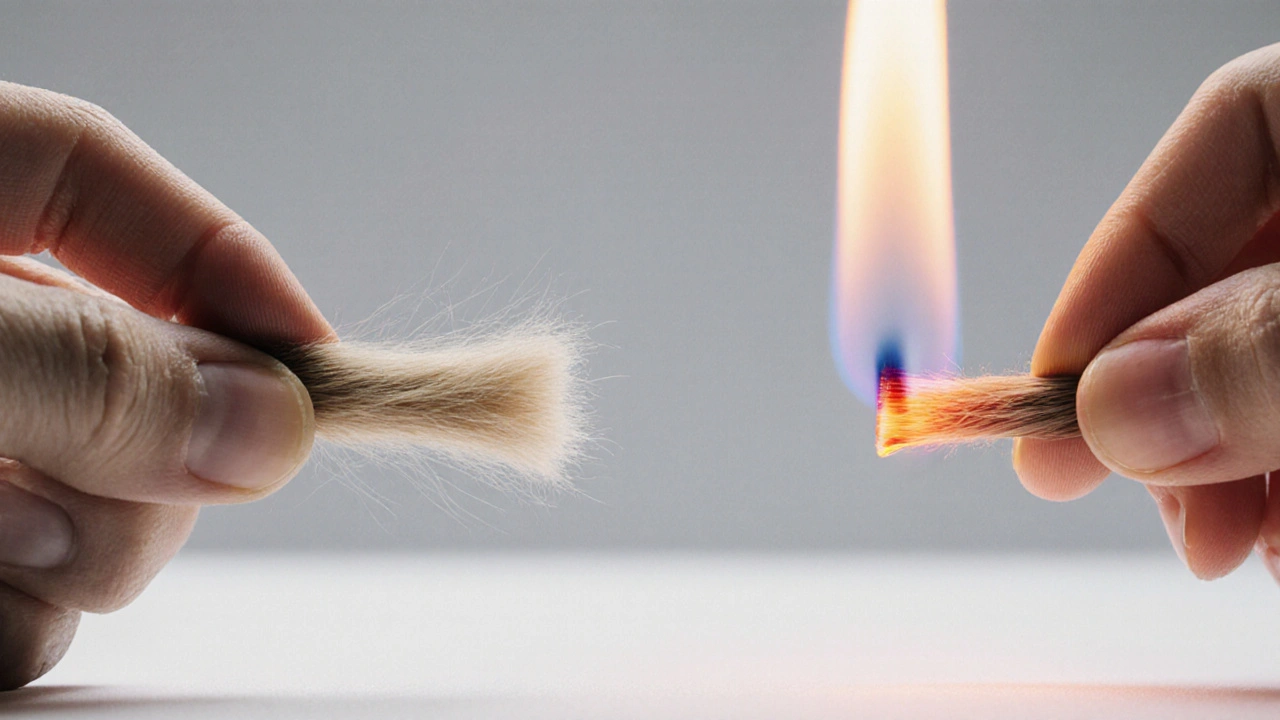Ever wondered why your new extensions feel stiff, shed like a brush, or make your thin hair look flat? The culprit is often the quality of the extensions themselves. Knowing the warning signs lets you avoid pricey disappointments and keeps your natural hair healthy.
When you shop for low quality hair extensions, the stakes are higher if you have fine or thin hair. Heavy, poorly crafted pieces can tug at the scalp, cause breakage, and expose you to irritating chemicals. Below is a practical guide that walks you through the tell‑tale clues, testing tricks, and a quick checklist so you can shop with confidence.
What defines a low‑quality hair extension?
Hair extensions are add‑on strands designed to add length, volume, or color to natural hair. They range from premium, ethically sourced human hair to cheap synthetics that fray after a few washes. Low quality typically means:
- Cheap raw material (low‑grade human hair or synthetic fibers).
- Flimsy construction (poor stitching, weak bonding agents).
- Excessive weight or density for your hair type.
- Unpleasant odor, unnatural shine, or rough texture.
- Lack of transparency from the seller.
Material red flags
Human hair is harvested from donors and can be graded from low to Remy quality. Here’s what to watch for:
- Low‑grade human hair: often a blend of several donors, tied together with a rough weft that can cause tangling.
- Remy hair is the gold standard because the cuticles stay aligned, reducing frizz. If a product claims “Remy” but the price is suspiciously low, it’s probably a false label.
- Synthetic hair is plastic‑based, shines unnaturally, and melts under heat. For thin hair, synthetics add weight without the natural drape you need.
Construction issues that matter
The way extensions are attached determines durability and how gentle they are on fine hair.
- Clip‑in extensions use metal or plastic clips. Low‑quality clips can snag, rust, or slip, making the extensions feel heavy.
- Tape‑in extensions rely on adhesive strips. Cheap adhesives emit strong chemical smells and lose grip after a few washes.
- Bonding adhesive (glue, keratin, or tape) that hardens quickly can pull on delicate roots, leading to breakage.
- Weft stitching that’s uneven or uses flimsy thread will unravel, shedding hair strands onto your pillow.
Weight and density: the thin‑hair dilemma
If you have fine hair, you’re essentially adding extra weight to strands that are already light. Extensions that are too heavy or dense create tension at the scalp.
- Check the gram weight per 100cm. Good quality extensions for thin hair typically weigh ≤30g per 100cm.
- Density should match your natural hair’s thickness. Over‑dense pieces look bulky and can pull the roots.
- Feel the braid or strand in your hand - it should be supple, not stiff like a rope.

Look, feel, and smell: sensory clues
The right extensions feel soft, have a natural sheen, and carry a faint, clean scent. Low‑quality ones often betray themselves:
- Excessive shine: Synthetic fibers reflect light like plastic, making the hair look fake.
- Rough texture: Hair that feels sandpaper‑like will tangle easily.
- Pungent odor: A strong chemical or “rubber” smell indicates cheap adhesives or synthetic fibers.
- Shedding test: Gently run your fingers through the strand; if many fibers fall out, the weft is poorly made.
Quick tests before you buy
- Pull test: Hold a small bundle and tug gently. Premium extensions should resist pulling without shedding.
- Burn test (only on a scrap piece): Light a tiny tip. Human hair smells like burnt hair and leaves a soft ash; synthetic hair melts and emits a chemical odor.
- Vendor verification: Look for clear photos, batch numbers, and a return policy. Reputable sellers often provide certificates of origin.
- Return policy check: Good vendors allow a 14‑day return if the extensions don’t match the description.
Maintenance pitfalls that reveal low quality
Even the best extensions can suffer if you treat them poorly, but low‑quality ones make mistakes obvious:
- Using high heat styling tools on synthetic hair leads to melting and a crispy smell.
- Skipping regular brushing causes tangles that pull at fine roots, resulting in breakage.
- Washing with harsh sulfates strips the few natural cuticles left, making the hair feel brittle.
- Leaving adhesive residue on the scalp can cause irritation and redness.
Quality checklist you can print
- Material: 100% Remy human hair or high‑grade human hair.
- Construction: Even stitching, rust‑free clips, strong yet flexible adhesive.
- Weight: ≤30g per 100cm for fine hair.
- Density: Matches natural hair thickness; avoid overly dense bundles.
- Scent: Light, clean; no chemical or rubber smell.
- Feel: Soft, smooth, natural movement when tossed.
- Vendor credibility: Detailed photos, batch info, clear return policy.
Low‑vs‑High Quality Extension Comparison
| Attribute | Low‑Quality | High‑Quality |
|---|---|---|
| Material | Mixed human hair or synthetic | 100% Remy human hair |
| Cuticle alignment | Random, prone to frizz | Aligned, smooth |
| Weight (g/100cm) | 35‑45g (too heavy for thin hair) | ≤30g |
| Adhesive | Cheap glue, strong odor | Medical‑grade keratin or tape, low odor |
| Durability | 1‑2months, high shedding | 4‑6months with proper care |
| Appearance | Plastic shine, static | Natural luster, blends seamlessly |
Final thoughts
Spotting low‑quality hair extensions isn’t rocket science - it’s about using your senses, doing a few simple tests, and buying from transparent sellers. Follow the checklist, and you’ll keep your thin hair looking full without the damage.
Frequently Asked Questions
How can I tell if my extensions are made of real human hair?
Do a small burn test on a stray strand. Real human hair smells like burnt hair and turns to soft ash; synthetic fibers melt and release a chemical odor.
What weight is safe for extensions on fine hair?
Aim for 25‑30g per 100cm. Anything heavier puts extra tension on delicate roots and can cause breakage.
Can I style low‑quality extensions with heat?
Usually not. Synthetic or low‑grade hair melts, and cheap adhesives can release fumes. Use low‑heat tools and a heat protectant if you must.
Is a strong chemical smell a sign of bad extensions?
Yes. A sharp rubber or solvent odor often means cheap glue or synthetic fibers, both of which are red flags.
How often should I wash low‑quality extensions?
Limit washing to once every 7‑10days. Over‑washing accelerates shedding and can weaken weak stitching.







Nathan Jimerson
October 15, 2025 AT 01:03Spotting cheap extensions starts with a quick feel test-if the strand snaps like a twig or sheds like a brush, it’s probably low‑grade. Look for a natural sheen and a faint, clean scent, not a plastic shine or chemical odor. Staying alert while you shop can save both money and your delicate scalp.
Yashwanth Gouravajjula
October 15, 2025 AT 03:00In many cultures, hair is treated as a sacred gift; choosing remy‑grade strands respects that tradition while protecting fine hair from excess weight.
Kendall Storey
October 15, 2025 AT 05:46When you’re evaluating clip‑ins, check the tensile strength of the metal prongs-low‑grade alloy will bend under minimal tension and cause snagging. A solid pull test reveals the bonding agent’s durability, and if the adhesive releases a pungent solvent smell, ditch it. Trust the data, not the glossy marketing.
Ashton Strong
October 15, 2025 AT 08:33Thank you for highlighting the essential checkpoints; a systematic approach indeed makes discerning quality far more manageable. Firstly, the material provenance should be verifiable, with suppliers providing certificates of origin for 100 % Remy human hair. Secondly, the cuticle alignment must be uniform, as misaligned cuticles precipitate frizz and premature shedding. Thirdly, the weight per 100 cm ought not to exceed thirty grams for individuals with fine strands, thereby mitigating undue tension on the follicle. Fourth, the construction technique-be it stitching, bonding, or clipping-should employ durable, non‑corrosive components that resist oxidation over time. Fifth, the odor profile is an indispensable sensory cue; a faint, clean scent denotes high‑grade adhesive, whereas a strong solvent aroma signals cheap glue. Sixth, a brief burn test on an inconspicuous fiber offers definitive proof of human versus synthetic composition. Seventh, the vendor’s return policy should be transparent, preferably allowing a fourteen‑day window for exchanges. Eighth, regular maintenance, such as gentle brushing and sulfate‑free washing, prolongs the lifespan of premium extensions. Ninth, avoid excessive heat on synthetic bundles, as this can lead to deformation and a lingering acrid smell. Tenth, ensure the density matches your natural hair’s volume, as over‑dense pieces not only appear bulky but also impose mechanical stress on the scalp. Eleventh, inspect the weft for uniform stitching; inconsistent thread can unravel, shedding strands onto pillows and garments. Twelfth, appreciate the visual luster; a natural, low‑gloss finish integrates seamlessly with your own hair. Thirteenth, consider the ethical dimension-sourcing hair responsibly respects donors and reduces the likelihood of mixed‑grade material. Fourteenth, keep a log of the extension’s performance, noting any signs of breakage or discomfort. Lastly, share your findings with the community, as collective knowledge empowers all users to make informed purchases. By adhering to these comprehensive guidelines, you will maintain the health of your thin hair while enjoying the aesthetic benefits of quality extensions.
Steven Hanton
October 15, 2025 AT 11:20Considering the burn test, remember that a subtle, smoky aroma indicates genuine human hair, while a sharp chemical scent reveals synthetic fibers; integrating this with a tactile assessment yields a reliable verdict.
Pamela Tanner
October 15, 2025 AT 14:06When verifying vendor authenticity, request batch numbers and cross‑reference them with the manufacturer’s database; this practice eliminates counterfeit claims and ensures traceability.
Kristina Kalolo
October 15, 2025 AT 16:53Another practical tip is to run a handful of strands through a fine-tooth comb; if they tangle excessively, the cuticle alignment is likely compromised.
ravi kumar
October 15, 2025 AT 19:40It helps to keep a small sample of the weft in a sealed bag and perform the pull test after a few days; the consistency of resistance will confirm the stitching quality.
Megan Blakeman
October 15, 2025 AT 22:26I love that the checklist is so clear!!! :) It makes shopping feel less scary and more like a fun project.
Akhil Bellam
October 16, 2025 AT 01:13Honestly, if the extensions glitter like a disco ball, they’re definitely not for delicate hair!!!
Zoe Hill
October 16, 2025 AT 04:00Dont forget to check the weight per 100cm; a lil over can pull on your roots and cause breakes.
Albert Navat
October 16, 2025 AT 06:46Dude, the adhesive specs are key-look for medical‑grade keratin, otherwise you’re basically gluing cheap plastic to your scalp.
Tyler Durden
October 16, 2025 AT 09:33Remember, your scalp’s health is the priority-if anything feels off, trust that instinct; a quick brush session can reveal hidden snag points, and a gentle wash with sulfate‑free shampoo will keep the extensions supple.